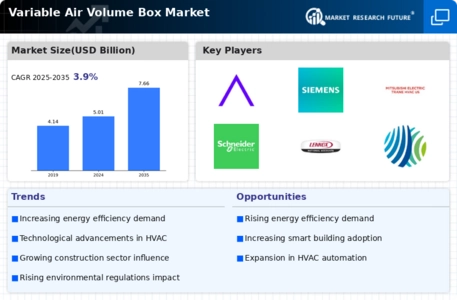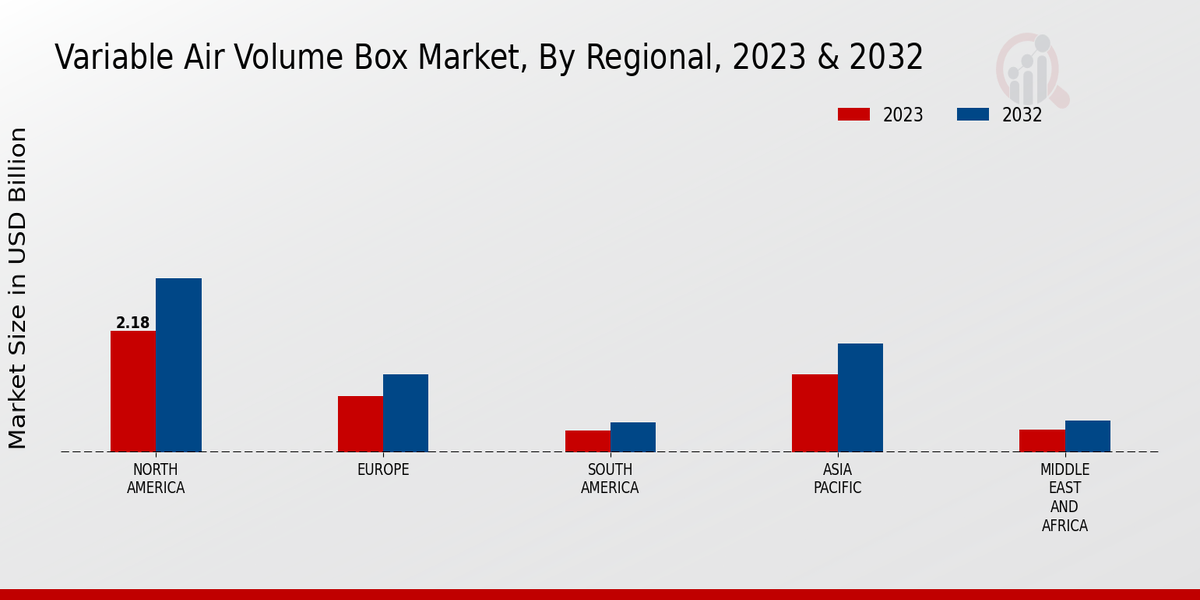Market Growth Projections
The Global Variable Air Volume Box Market Industry is poised for substantial growth, with projections indicating a market value of 5.01 USD Billion in 2024 and an expected increase to 7.66 USD Billion by 2035. This growth trajectory suggests a compound annual growth rate of 3.93% from 2025 to 2035. The market dynamics are influenced by various factors, including technological advancements, regulatory support, and increasing demand for energy-efficient solutions. These projections highlight the potential for innovation and investment within the industry, as stakeholders seek to capitalize on emerging opportunities in the HVAC sector.
Growth in Commercial Construction
The Global Variable Air Volume Box Market Industry is significantly influenced by the growth in commercial construction activities worldwide. As urbanization accelerates, there is a corresponding increase in the demand for efficient HVAC systems in new commercial buildings. Variable air volume boxes are essential components in modern HVAC designs, allowing for flexible and efficient air distribution. This trend is expected to contribute to a compound annual growth rate of 3.93% from 2025 to 2035, indicating a robust market outlook. The expansion of commercial spaces, including offices, retail, and hospitality, further underscores the necessity for advanced air management solutions.
Rising Demand for Energy Efficiency
The Global Variable Air Volume Box Market Industry is experiencing heightened demand for energy-efficient HVAC systems. As energy costs continue to rise, building owners and operators are increasingly seeking solutions that reduce energy consumption while maintaining comfort levels. Variable air volume boxes are pivotal in achieving these goals, as they allow for precise control of airflow and temperature. This trend is underscored by the projected market value of 5.01 USD Billion in 2024, reflecting a growing recognition of the importance of energy efficiency in building design and operation. The adoption of these systems is likely to accelerate as regulatory frameworks increasingly favor sustainable practices.
Increased Awareness of Indoor Air Quality
The Global Variable Air Volume Box Market Industry is also benefiting from a growing awareness of indoor air quality (IAQ) among consumers and businesses. As health concerns related to air quality gain prominence, there is a rising demand for HVAC systems that can effectively manage air distribution and filtration. Variable air volume boxes play a vital role in maintaining optimal IAQ by allowing for precise control over airflow and temperature. This heightened focus on IAQ is expected to drive market growth, with an anticipated increase in market value to 7.66 USD Billion by 2035. The emphasis on healthier indoor environments is likely to influence purchasing decisions in the HVAC sector.
Technological Advancements in HVAC Systems
Technological innovations are driving the evolution of the Global Variable Air Volume Box Market Industry. The integration of smart technologies, such as IoT and advanced sensors, enhances the functionality and efficiency of variable air volume boxes. These advancements enable real-time monitoring and control of air distribution, leading to improved indoor air quality and occupant comfort. As the market progresses towards an estimated value of 7.66 USD Billion by 2035, the role of technology in optimizing HVAC systems becomes increasingly critical. This trend suggests that manufacturers who invest in research and development will likely capture a larger share of the market.
Regulatory Support for Sustainable Practices
Regulatory frameworks across various regions are increasingly promoting sustainable building practices, which positively impacts the Global Variable Air Volume Box Market Industry. Governments are implementing stricter energy efficiency standards and incentives for the adoption of advanced HVAC technologies. These regulations encourage the use of variable air volume boxes, which are recognized for their ability to optimize energy use and reduce greenhouse gas emissions. As the market adapts to these regulatory changes, it is likely to see enhanced growth, with projections indicating a market value of 5.01 USD Billion in 2024. This regulatory support is crucial for fostering innovation and driving market expansion.



















Leave a Comment